Steel Framing
The Impact of the Selection of the Structural Shape
Different member shapes, different connection strategies. As will seen throughout this web site, the choice of the shape of the structural section that is being connected will have a tremendous impact on the details designed to connect the members. Although the general idea behind the connection - transfer of vertical, horizontal or bending forces - is the same for all connections, the details are not the same for different shapes of steel. The shape impacts how connecting devices can be attached - both in terms of geometry as well as method of attachment. The decision to bolt or weld will also impact, and be impacted by the structural shape and assist in determining the best method for creating a connection. If there are different shapes in a framing assembly and the desire is to create a coherent "family" of details, then this will be important to think of when deciding on the connection design.
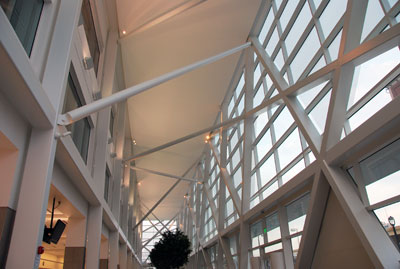 |
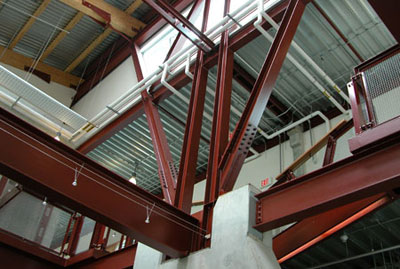 |
The framing for this Transit Terminal in Wisconsin uses welded connections and hollow structural sections. Some bolted pin connections are used for the bracing members. |
The framing for the National Works Yard in Vancouver, BC, uses wide flange sections with a combination of welded and bolted connections. |
Shapes with Webs and Flanges
Members with webs and flanges - wide flange beams, channels and angles - are simple to connect as they can make use of the basic framing connection language of standard steel buildings. However, using these sorts of shapes in Architecturally Exposed Structural Steel buildings requires more care and a bit of inventiveness in the modification of the standard details. When these shapes are used in an exposed location, care must also be taken to orient them so that they do not collect dirt, debris or moisture. One of the key design moves will be to decide upon the orientation of the flange members as structures, particularly trusses, look and fabricate quite differently if members are oriented differently.
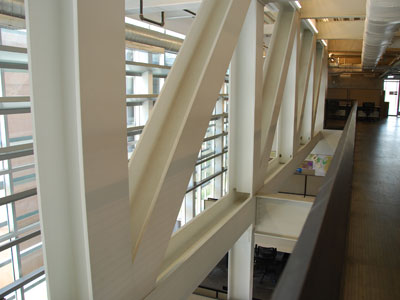 |
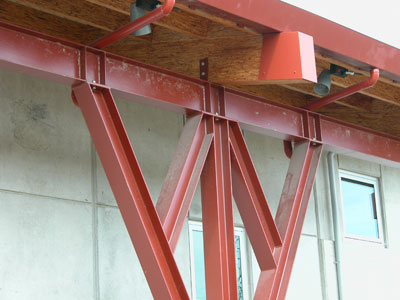 |
This very large AESS truss at the School of Architecture at the University of New Mexico is fabricated from wide flange sections. The truss makes use of fully welded connections. Bolted connections to the face of the truss are used to attach beams that frame into the truss to support an adjacent walkway. |
This fully welded truss/column at the National Works Yard in Vancouver has chosen to orient the webs to face the exterior face of the building. This results in a very different look and connection language. Simple bolted connections are visible to attach the beam running along the top to the support. |
When designing with standard structural sections it is possible to be creative and double up paired channel sections in lieu of a wide flange section. This can add visual interest to the structure and sometimes provide a discreet space in which to run services.
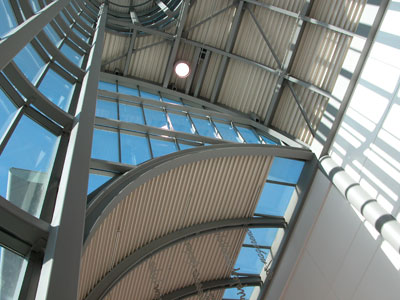 |
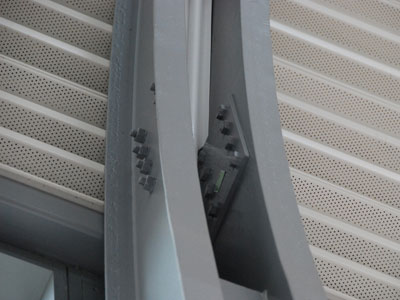 |
The curved structure that supports the roof at the Direct Energy Centre in Toronto is fabricated from curved pairs of channel sections. |
The space between the channel sections is used to hide/mount lights as well as to run some electrical services. |
It is important to take into account whether or not standard sections will be used exclusively on the project. It is quite common for a range of section types to be employed that suit the fabrication requirements, structural requirments or aesthetics.
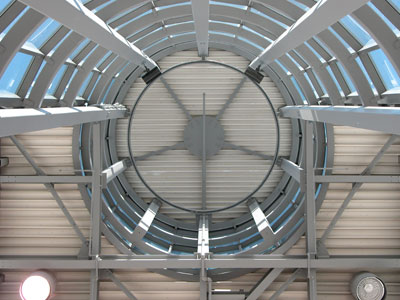 |
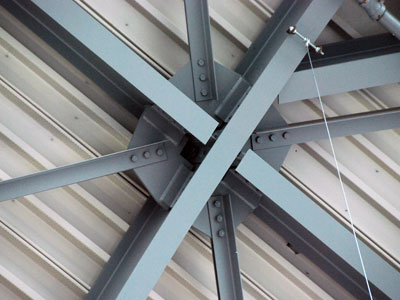 |
The round lanterns at the Direct Energy Centre are framed with square HSS sections. These both complement and contrast the curved channels used for the roof. |
The bracing for the roof is provided by simple wide flange beams, joined with coped connections for a clean appearance. Plates with angles are used to satisfy cross bracing needs. |
Tubular Steel
Tubular steel - generally hollow structural sections or occasionally mechanical pipe - is often chosen when creating AESS projects. In the case of HSS, the section shapes can be square, rectangular, round or elliptical. Mechanical pipe is only produced round and cannot be used in seismic applications. The choice of the member shape will have a tremendous impact on the design and appearance of the connections. The geometry of the connection - planar, simple angle or multi member intersection - will impact the cost and complexity of resolving multiple HSS shapes. In some instances the joint can be resolved by cutting and welding. In other instances plates may be needed to simplify the intersection and erection.
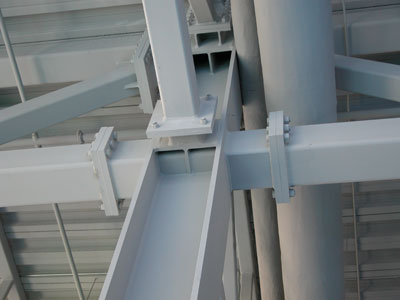 |
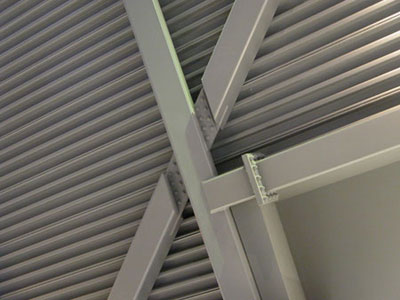 |
The simplest way to join two HSS segments "in a line" is to weld plates to the end of the members and bolt the plates together. Here we see how HSS stubs have been welded to this wide flange column to permit this type of connection. |
This detail illustrates both the end plate attachment for the HSS as well as the use of an inset splice plate. The inset splice plate requires more care during fabrication, particularly in this case due to the angular cut of the member. |
In general, HSS tends to be produced using a welding process, whereas pipe tends to be the result of an extrusion process. All HSS sections start out round and are formed to alternate shapes. There will be a welded seam along the HSS, whereas in pipe the shape will be seamless. When designing with HSS the AESS Characteristics ask that you look at the orientation of this weld seam in the design. A welded seam will tend to be visible even after grinding, depending on the coating process used, as one can only grind perpendicular to a surface. Although there is variance of final texture in extruded shapes and on the coating system used, the final look is likely to reflect the initial relief of the surface. As grinding may not completely conceal the weld seam, even after finish coatings are applied, it is preferable (and less expensive) to simply orient this natural occurence consistently or away from the dominant angle of view.
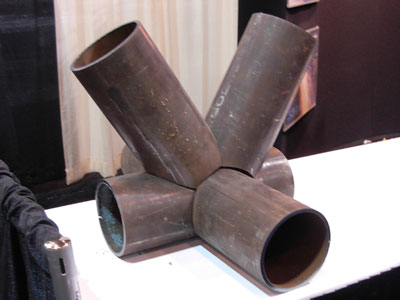 |
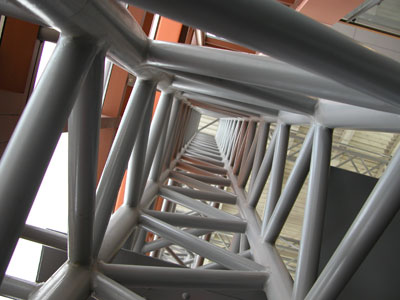 |
Modern ways to cut steel make it easier to achieve fairly seamless looking connections when joining tubes to tubes. This raw assembly of circular HSS members illustrates how close the preparatory cutting can be, given the correct equipment. |
This fully welded truss at the offices of Waiward Steel illustrates a very high level of workmanship. Here the connection strategies for joining a complete assembly of circular HSS dominated all design and fabrication decisions. |
The surface of the welded HSS tends to resemble that of a rolled shape, whereas the pipe may exhibit a light texture akin to an orange peel. This textural difference may be significant if combining hollow section types with other structural shapes in an AESS application where a high level of consistency of finish is desired. Pipe sections are rarely used and are considered a "back up plan" for most fabrication.
There will be a variability in the availability of different section sizes and it is not the same for different diameter ranges. Check with your local service centre for current availability. For large quantities (i.e. over 50 to 70 tonnes) an order can be placed directly to the structural tubing mill. HSS sections with a diameter greater than 400mm generally require special ordering. Larger diameter tubes (diameter > 500mm) will be custom manufactured and will require a minimum 100-tonne quantity when ordering unless they can be bundled with another job. As helical welds are sometimes proposed for large tubular sections, it is important to be sure to discuss this with your fabricator and explicitly exclude these in your AESS specification documents if they are not acceptable.
It makes a great deal of difference whether or not joining HSS are to be identical in size. If there is a desire for a "planar look", then greater care will be needed to ensure that the joining surfaces are level and the the welds are remediated. If the members are different sizes, then the welding is much simpler as fillet welds can be used with little to no remediation.
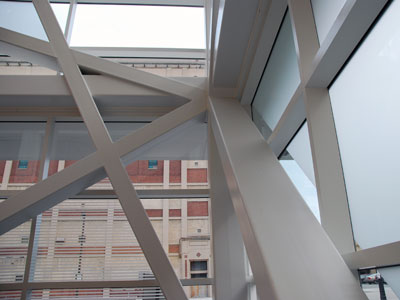 |
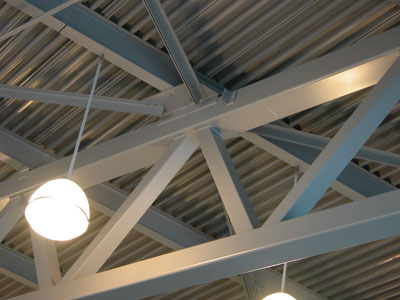 |
The square HSS that creates the innovative structure for this Transit Terminal in Milwaukee requires that the tube be in line. Although the joining welds are still perceptible, great care has been taken to create a seamless looking appearance. |
The major trusses at the Canadian War Museum use smaller square HSS for the web members. This makes the fabrication simpler as fillet welds can be used. You can see that the wide flange beams that frame the roof sit simply on top of the truss. |
Tapered tubes are not a regular manufactured product. They must be custom fabricated from a trapezoidal plate that is rolled to form a tapered pole and the seam welded.
Combinations of HSS and Standard Structural Steel
The majority of projects will end up using a combination of HSS and standard structural shapes. Some will be separated into different systems for different portions of the structure. Some will be required to interact through some significant, very apparent connections. The detailing language needs to understand from the outset of the project the nature of the structural shapes and work to create a unified language of connection.
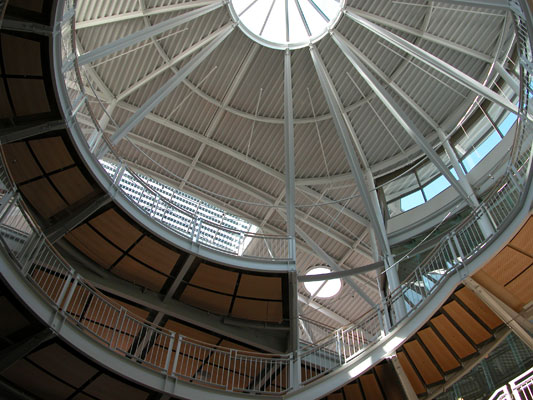 |
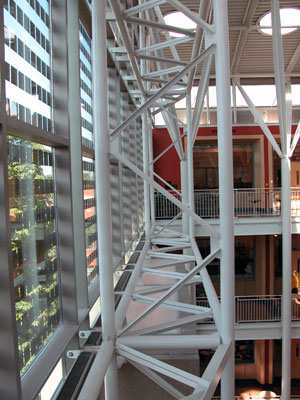 |
The Lillis School of Business in Eugene, Oregon uses a combination of HSS and standard structural shapes to create the unified language of this atrium. Round HSS is used for the column elements and the balance of the structure is comprised of wide flanges and angle section. |
The trusses that support the large glazed end wall are fabricated from round HSS and paired angles. This provided cost saving in terms of the simplication of fabrication. |
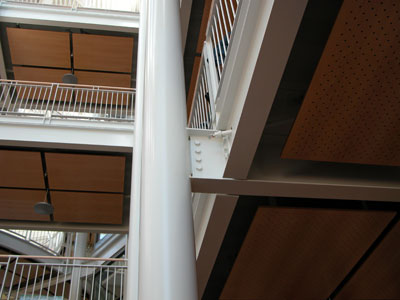 |
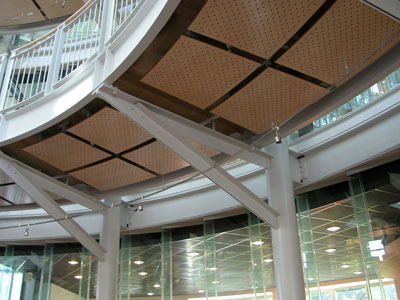 |
Plates are welded to the back side of the round columns to provide a means of attachment for the floor beams. Angles as would be common in wide flange to wide flange connections cannot be used. Also it must be noted that you cannot bolt "into" an HSS member to achieve a connection as there is no access to the back side to fasten the nut. Therefore, welded plates must be used. |
These cantilevered outriggers that support the walkway of the atrium are fabricated from paired angle sections. Curved channel sections form the front edge of the walkway at the base of the railing. The channels have been bent the "easy" way - simpler than bending wide flange sections of the same depth. |
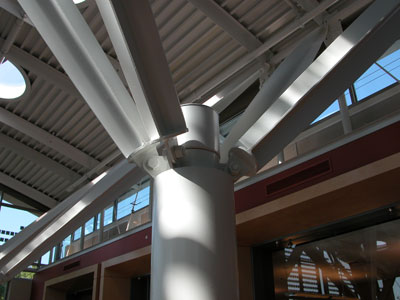 |
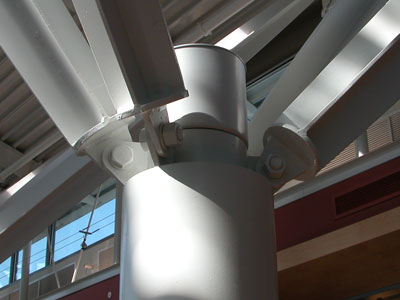 |
The struts that support sections of the Lillis skylight are custom fabricated into X shapes in cross section with plate material. They are cut to taper towards the ends, making them appear more elegant. |
A closer look at the top connection shows the simple lapped pin connection by which they are attached. |
Elliptical Tubes
Elliptical tubes are relatively new to the AESS scene. Their use started in Europe and is making its way into North American architecture. EHS have greater bending capacity than circular hollow sections of the same area or weight, due to having strong and weak axis directions, but still maintain a smooth closed shape. There is also reduced visual intrusion compared to regular circular HSS , if the member is viewed from one predominant direction.
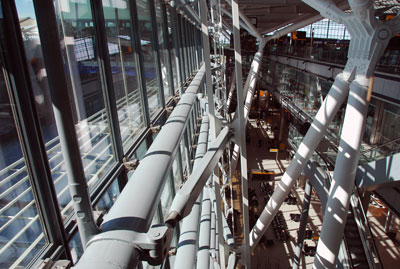 |
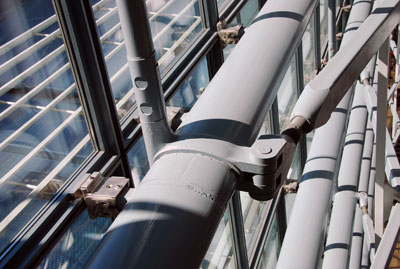 |
Elliptical hollow structural sections have been used at Heathrow Airport Terminal 5, in London, England, designed by Richard Rogers. The slender profile of the section better suited its structural location in front of the glazing wall. |
Here you can see that these tubes are being used to support the sun shades outside of the glass. Different fittings are used to attach the bracing members to the tubes. A welded splice is evident as the shipping length is not nearly sufficient for the length required for the airport. Any more obvious/simpler splice method would not have been acceptable. |
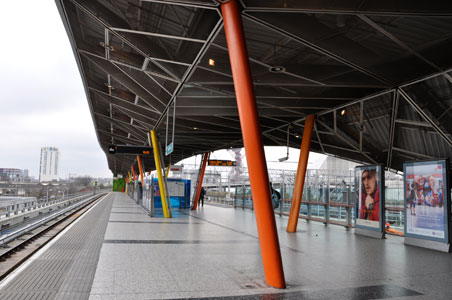 |
 |
Elliptical hollow structural tubes are used well at the Stratford DLR Station in London, England. The opposing sloped angles of the tubular supports, staggered down the length of the station, works well to create an architectural highlight for the structure. |
The narrow side of the tube is oriented to make it appear more slender along the length of the station. |
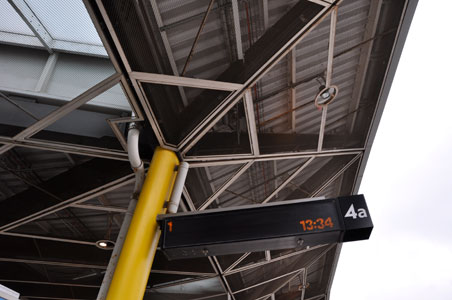 |
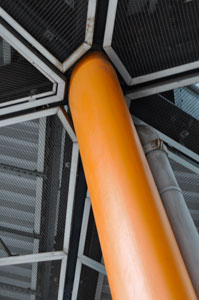 |
A view up to the roof of the Stratford DLR Station. The choice of roofing material - profiled decking - is quite ordinary compared to the brightly coloured tubes. However the contrast works well. |
In this instance the top connection of the elliptical tube to the roof structure is obscured by a light screen that is intended to prevent pigeons from roosting. |
All EHS are produced, with major-to-minor axis dimensions of 2:1, as hot finished hollow structurals. They are produced as continuously welded sections, joined by high frequency induction welding and finished to their final shape at extremely high (normalizing) temperatures, with the outside weld bead removed but the inside weld bead typically left in place. Due to the hot finishing process EHS have a fine grain structure, uniform mechanical properties, excellent weldability, negligible residual stress, are suitable for hot-dip galvanizing and are applicable for dynamic loading situations. Elliptical tubes have similar material properties as regular HSS members and similar connection methods can be used in their connection detailing. They are often used in front of glazing as their shape is less obtrusive and blocks less of the view and light coming into the space.
References: Modern Steel Construction March 2008. "Going Elliptical" by Jeff Packer, Advantage Steel No. 35, Fall 2009 "Elliptical Hollow Sections Three-Part Series Part One: Properties And Applications " by Jeff Packer. and Advantage Steel No. 37, Summer 2010 "Elliptical Sections Three-Part Series Part Three: EHS Connection Design" by Jeff Packer.
